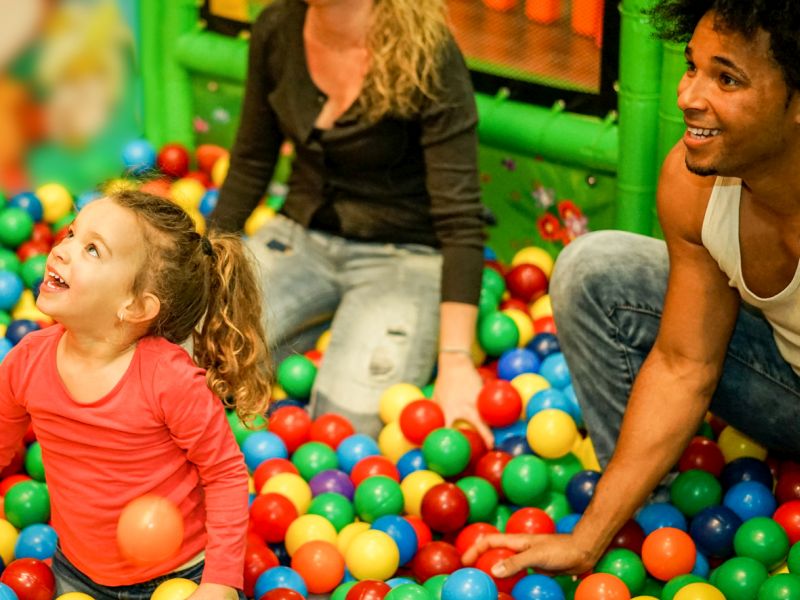Are Kids' Ball Pits Jumping With Germs?
By Serena GordonHealthDay Reporter

TUESDAY, March 26, 2019 (HealthDay News) -- If the cacophony of children screaming and throwing tiny plastic balls everywhere hasn't prompted you to forgo ball pits, a new study may just send you scurrying for the door.
The research found that ball pits in physical therapy clinics -- and undoubtedly in public ball pits, too -- were awash in microbes, some potentially quite dangerous.
The study team found 31 bacterial species and one species of yeast. Some of those bugs are responsible for pink eye, urinary tract infections, bloodstream infections, heart inflammation and more.
"Be aware of this if you take your child to a physical therapy clinic, especially if the child has a compromised immune system," said senior study author Dobrusia Bialonska, assistant professor of environmental microbiology at the University of North Georgia.
"You might consider asking for no treatment in the ball pit. We definitely showed that there are things on the balls that can potentially hurt a child who is immune-compromised," she said.
Does that mean all kids need to steer clear of ball pits in fast food restaurants or other play spaces?
No, Bialonska said.
"We're talking about pediatric physical therapy patients that may have some immune problems and may be more fragile. If kids are healthy, let them go and play. It may help build their immune system," she said.
But kids should wash their hands when they jump out of the pit, especially if they're going to eat after playing, Bialonska quickly added.
Ball pits became popular in the 1980s when they began popping up in commercial restaurant chains across the United States. But these play areas are often contaminated with visible dirt, vomit, urine and feces, researchers said. Numerous bacteria had already been identified in ball pits, but researchers wanted to learn how those used for physical therapy for children might compare.
The study team collected samples from six ball pits in Georgia physical therapy clinics. They randomly selected nine to 15 balls from each location, then swabbed the whole surface of each ball to find any microbes.
There were microorganisms on all of the balls, though some had very few. The researchers said it's not unusual or concerning to see microbes anywhere humans are present. There should be concern when there are a lot of microbes, however.
Researchers noted a significant variation in the extent of microbial contamination from clinic to clinic. That suggests a need to develop guidelines for cleaning the balls and the pit area when they are used for physical therapy in potentially vulnerable kids, researchers said.
Bialonska said there are no standards or directions for cleaning these areas. She said someone had used a commercial washing machine to clean the balls. Others have tried using ultraviolet light to disinfect the balls.
Dr. Maryann Buetti-Sgouros, chair of pediatrics at Northern Westchester Hospital in Mount Kisco, N.Y., was not involved with the research, but reviewed the study.
"Common sense has to dictate how you address risks as a parent," she said. "If there's somewhere germy, what will you do to decrease the risk? A little bit of germs isn't awful. Carry antibiotic wipes."
Another expert agreed.
"Many of the microbes isolated are part of our normal flora," said Dr. Salman Khan, an infectious disease physician at Lenox Hill Hospital in New York City. "However, some of these have the potential to cause disease in patients with immunocompromising conditions and open wounds."
Buetti-Sgouros said she doesn't think ball pits are inherently worse than other places where kids play, but the balls cannot be sterilized between uses and are going to get covered in bacteria.
If you're taking a child for physical therapy where there is a ball pit, she suggested asking how the balls are sterilized. "In this study, one of the clinics didn't have as much bacteria. What were they doing differently?" she said.
Buetti-Sgouros also pointed out that injuries are a concern at ball pits and other kid play areas, such as those with multiple indoor trampolines.
"Again, let common sense dictate. But, I'd rather see kids outside where there's ventilation and air," she said.
The study was recently published in the American Journal of Infection Control.
More information
Since kids do get dirty, here's some information from the U.S. Centers for Disease Control and Prevention on hand-washing.

The news stories provided in Health News and our Health-E News Newsletter are a service of the nationally syndicated HealthDay® news and information company. Stories refer to national trends and breaking health news, and are not necessarily indicative of or always supported by our facility and providers. This information is provided for informational and educational purposes only, and is not intended to be a substitute for medical advice, diagnosis, or treatment.

